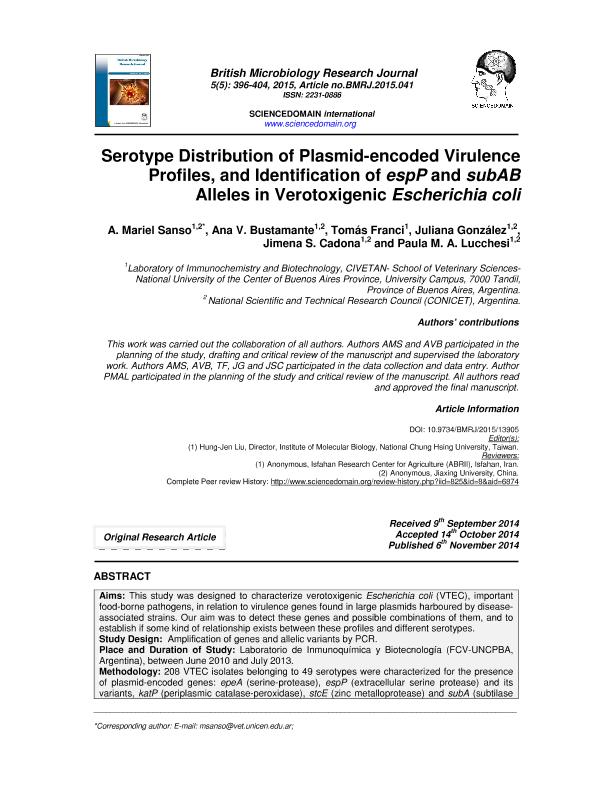Mostrar el registro sencillo del ítem
dc.contributor.author
Sanso, Andrea Mariel

dc.contributor.author
Bustamante, Ana Victoria

dc.contributor.author
Franci, Tomas

dc.contributor.author
González, Juliana

dc.contributor.author
Cadona, Jimena Soledad

dc.contributor.author
Lucchesi, Paula Maria Alejandra

dc.date.available
2017-11-10T20:11:31Z
dc.date.issued
2014-11
dc.identifier.citation
Sanso, Andrea Mariel; Bustamante, Ana Victoria; Franci, Tomas; González, Juliana; Cadona, Jimena Soledad; et al.; Serotype distribution of plasmid-encoded virulence profiles, and identification of espP and subAB alleles in verotoxigenic escherichia coli; Science Domain International; British Microbiology Research Journal; 5; 5; 11-2014; 396-404
dc.identifier.issn
2231-0886
dc.identifier.uri
http://hdl.handle.net/11336/27947
dc.description.abstract
Aims: This study was designed to characterize verotoxigenic Escherichia coli (VTEC), important food-borne pathogens, in relation to virulence genes found in large plasmids harboured by diseaseassociated strains. Our aim was to detect these genes and possible combinations of them, and to establish if some kind of relationship exists between these profiles and different serotypes. Study Design: Amplification of genes and allelic variants by PCR. Place and Duration of Study: Laboratorio de Inmunoquímica y Biotecnología (FCV-UNCPBA, Argentina), between June 2010 and July 2013. Methodology: 208 VTEC isolates belonging to 49 serotypes were characterized for the presence of plasmid-encoded genes: epeA (serine-protease), espP (extracellular serine protease) and its variants, katP (periplasmic catalase-peroxidase), stcE (zinc metalloprotease) and subA (subtilase cytotoxin) and its variants. Results: The most frequently detected gene was espP (87%), followed by ehxA (47%), saa (20%) and katP (17%), whereas epeA, subA and stcE ranged from 7 to 12%. Taking into account these genes, twelve profiles were observed, ranging from the presence of zero to five of the genes. Some serotypes presented only one plasmid profile whereas others, such as O20:H19, showed up to four different profiles. Functional differences have been previously found among EspP subtypes, and we found that several VTEC isolated from bovines or foods contained the espPα, which is one of the alleles possibly associated with severe human disease. Considering subtilase cytotoxin gene subtypes, only subAB1 was identified. Conclusion: Our results show that VTEC strains can possess different combinations of plasmidencoded virulence genes and even strains belonging to the same serotype can differ in relation to their plasmid genetic composition. In relation to allelic variants, LEE-positive serotypes showed for espP gene the allele α or the γ, and the detected subAB allele differed from the prevalent allelic variant subAB2 carried by strains circulating in sheeps and humans in European countries.
dc.format
application/pdf
dc.language.iso
eng
dc.publisher
Science Domain International
dc.rights
info:eu-repo/semantics/openAccess
dc.rights
Atribución-NoComercial-CompartirIgual 2.5 Argentina (CC BY-NC-SA 2.5 AR)
dc.rights.uri
https://creativecommons.org/licenses/by-nc-sa/2.5/ar/
dc.subject
Plasmid Profiles
dc.subject
Verotoxigenic Escherichia Coli
dc.subject
Virulence
dc.subject
Espp Alleles
dc.subject
Subab Alleles
dc.subject.classification
Otras Ciencias Biológicas

dc.subject.classification
Ciencias Biológicas

dc.subject.classification
CIENCIAS NATURALES Y EXACTAS

dc.title
Serotype distribution of plasmid-encoded virulence profiles, and identification of espP and subAB alleles in verotoxigenic escherichia coli
dc.type
info:eu-repo/semantics/article
dc.type
info:ar-repo/semantics/artículo
dc.type
info:eu-repo/semantics/publishedVersion
dc.date.updated
2016-11-17T16:27:49Z
dc.journal.volume
5
dc.journal.number
5
dc.journal.pagination
396-404
dc.journal.pais
Reino Unido

dc.description.fil
Fil: Sanso, Andrea Mariel. Consejo Nacional de Investigaciones Científicas y Técnicas. Centro Científico Tecnológico Tandil. Centro de Investigacion Veterinaria de Tandil; Argentina
dc.description.fil
Fil: Bustamante, Ana Victoria. Consejo Nacional de Investigaciones Científicas y Técnicas. Centro Científico Tecnológico Tandil. Centro de Investigacion Veterinaria de Tandil; Argentina
dc.description.fil
Fil: Franci, Tomas. Consejo Nacional de Investigaciones Científicas y Técnicas. Centro Científico Tecnológico Tandil. Centro de Investigacion Veterinaria de Tandil; Argentina
dc.description.fil
Fil: González, Juliana. Consejo Nacional de Investigaciones Científicas y Técnicas. Centro Científico Tecnológico Tandil. Centro de Investigacion Veterinaria de Tandil; Argentina
dc.description.fil
Fil: Cadona, Jimena Soledad. Consejo Nacional de Investigaciones Científicas y Técnicas. Centro Científico Tecnológico Tandil. Centro de Investigacion Veterinaria de Tandil; Argentina
dc.description.fil
Fil: Lucchesi, Paula Maria Alejandra. Consejo Nacional de Investigaciones Científicas y Técnicas. Centro Científico Tecnológico Tandil. Centro de Investigacion Veterinaria de Tandil; Argentina
dc.journal.title
British Microbiology Research Journal
dc.relation.alternativeid
info:eu-repo/semantics/altIdentifier/doi/http://dx.doi.org/10.9734/BMRJ/2015/13905
Archivos asociados
